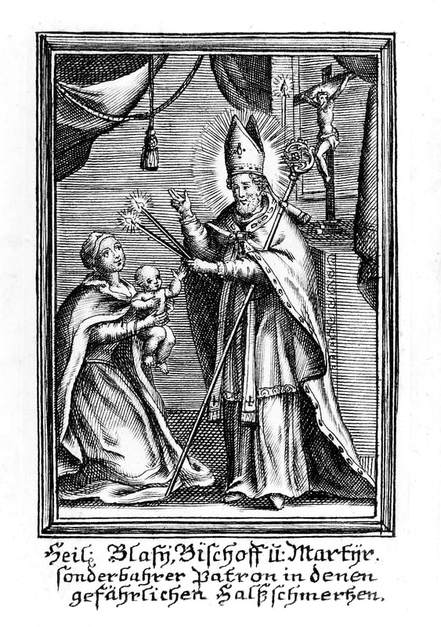
This was once an important rural festival, especially among women, who were accustomed to run into one another's houses with lighted brands, which they flung on the hearth, exclaiming: ‘St. Blaise for a blaze!’
This fifth-century saint was a Bishop of Dalmatia, and became the patron of Ragusa, the capital of that province. He was believed to cure sore throats, because his own throat was cut with a sword. In Cornwall (where he is said to have landed, and where a little village — St. Blazey — is named after him) he is also invoked against the toothache. He also heals diseases of cattle, and has power over wild animals.
An ancient custom in connection with this saint was observed on his feast day by the Benedictines of the Glorious Assumption of the Blessed Virgin Mary. It was described in 1915;
'This custom of the solemn blessing of St. Blaise's water at this monastery (according to the rite given in the Bollandists) is now over 200 years old, having been begun in 1673 when the Princess de Ligne gave the relic of the saint to the community then at Brussels. The water thus blessed is sent to all parts, and is taken as a cure for all diseases connected with the throat, many cures testifying to its efficacy. The water is sent to all who apply, who make a small offering for porterage. The fact that the blessed water can be kept for any length of time and can be used whenever needed makes it more convenient than the blessing with candles.'
As St. Blaise was said to have been martyred by having his flesh torn with iron combs, he has become
the patron saint of wool-combers!
St. Blaise's Day was kept by women as a holiday, and that under some penalty for breaking the rule. If any woman was found by her neighbours spinning on that day, their privilege was to break the distaff, and, in punning allusion to the saint's name, ‘make a Blaze of it!’
This fifth-century saint was a Bishop of Dalmatia, and became the patron of Ragusa, the capital of that province. He was believed to cure sore throats, because his own throat was cut with a sword. In Cornwall (where he is said to have landed, and where a little village — St. Blazey — is named after him) he is also invoked against the toothache. He also heals diseases of cattle, and has power over wild animals.
An ancient custom in connection with this saint was observed on his feast day by the Benedictines of the Glorious Assumption of the Blessed Virgin Mary. It was described in 1915;
'This custom of the solemn blessing of St. Blaise's water at this monastery (according to the rite given in the Bollandists) is now over 200 years old, having been begun in 1673 when the Princess de Ligne gave the relic of the saint to the community then at Brussels. The water thus blessed is sent to all parts, and is taken as a cure for all diseases connected with the throat, many cures testifying to its efficacy. The water is sent to all who apply, who make a small offering for porterage. The fact that the blessed water can be kept for any length of time and can be used whenever needed makes it more convenient than the blessing with candles.'
As St. Blaise was said to have been martyred by having his flesh torn with iron combs, he has become
the patron saint of wool-combers!
St. Blaise's Day was kept by women as a holiday, and that under some penalty for breaking the rule. If any woman was found by her neighbours spinning on that day, their privilege was to break the distaff, and, in punning allusion to the saint's name, ‘make a Blaze of it!’

 RSS Feed
RSS Feed